Standard [CURRENT]
ASTM B 858:2006
Standard Test Method for Ammonia Vapor Test for Determining Susceptibility to Stress Corrosion Cracking in Copper Alloys
- Publication date
- 2006 reapproved: 2024
- Original language
- English
- Pages
- 4
- Publication date
- 2006 reapproved: 2024
- Original language
- English
- Pages
- 4
- DOI
- https://dx.doi.org/10.1520/B0858-06R24
Product information on this site:
Quick delivery via download or delivery service
Buy securely with a credit card or pay upon receipt of invoice
All transactions are encrypted
Short description
1.1 This test method describes a procedure to determine the presence of residual stresses in wrought copper alloy products that may lead to stress corrosion cracking. An ammonia vapor atmosphere is used as an accelerated test. 1.2 This test method is only suitable for products fabricated from copper alloys that are known to be susceptible to stress corrosion cracking in ammonia vapor atmospheres. It is intended to create an environmental condition of reproducible severity.Note 1It is well known that the critical step in the cracking mechanism is the development of an environment in the condensate film that occurs on the surface of the test specimen, and is rich in copper complex ions. 1.3 The severity of this test method depends upon the pH of the corrosive solution. In are given four different atmospheres to which the product may be exposed, and the appropriate pH of the solution to be used for the test, depending on the risk level associated with the intended application. 1.3.1 The appropriate pH value for the test shall be specified in the product specification, or as per established agreement between the supplier and purchaser, with respect to the alloy and its intended application. 1.4 UnitsThe values stated in SI units are to be regarded as the standard. No other units of measurement are included in this standard. This standard does not purport to address all of the safety concerns, if any, associated with its use. It is the responsibility of the user of this standard to establish appropriate safety and health practices and determine the applicability of regulatory limitations prior to use.
ICS
77.120.30
DOI
https://dx.doi.org/10.1520/B0858-06R24
Also available in
Loading recommended items...
Loading recommended items...
Loading recommended items...
Loading recommended items...

